21 Essential System Design Building Blocks for Software Engineers
System Design Building blocks and Software Architecture components developer must know
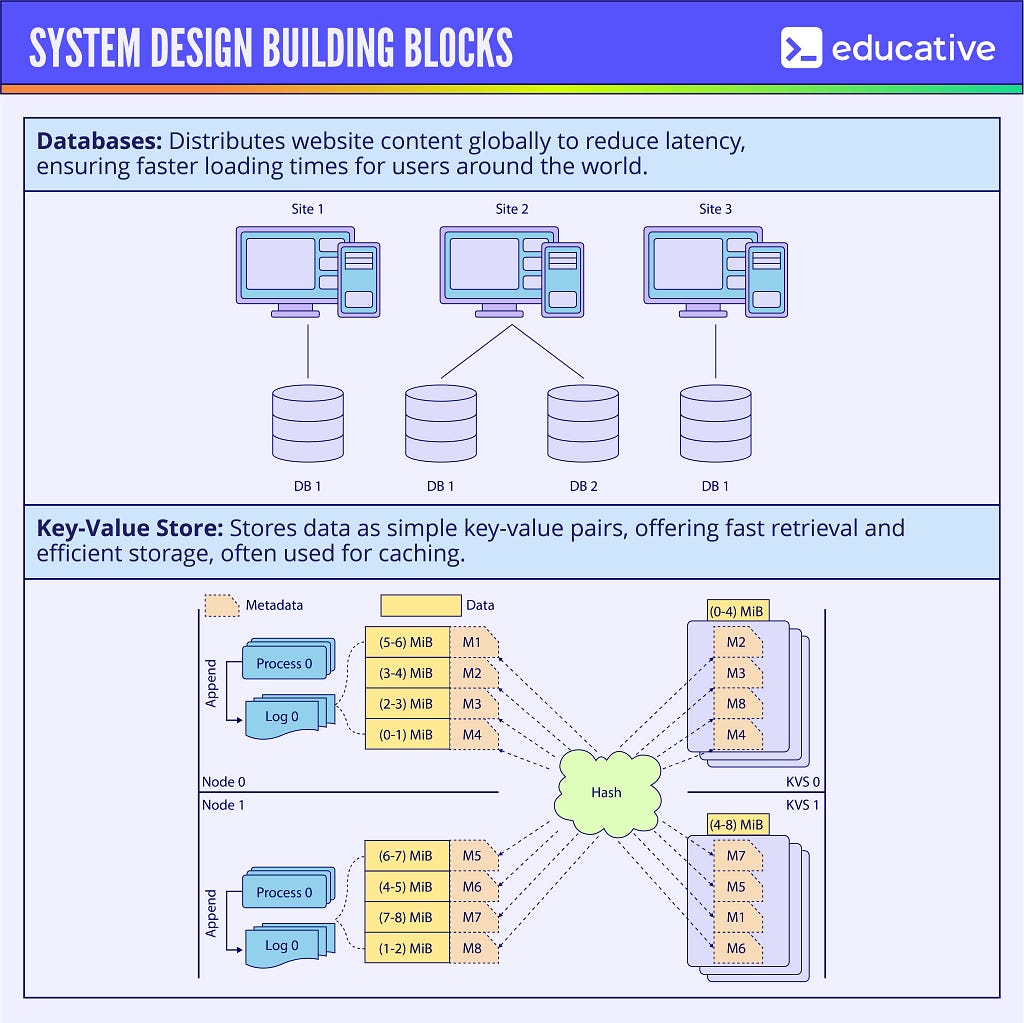
Hello guys, System design is not just important for interview but it is at the heart of building scalable, efficient, and reliable applications.
Whether you’re designing a distributed system, creating a high-availability platform, or optimizing your backend, understanding the essential building blocks is key to success.
If you don’t know how to design a system or not familiar with key software architecture components like API Gateway, Load Balancer, Caches etc. then it will be really hard for you to design a system which can withstand test of time in production.
In the past, I have shared the best System Design interview books, courses, cheat sheets, and websites and in this article, we’ll explore 20 critical system design concepts that every software engineer should know.
This includes essential software design building blocks like API Gateway, Load Balancer, CDN, Caches as well as Database, Rate Limiter etc.
By the way, if you are preparing for System design interviews and want to learn System Design in-depth then you can also check sites like ByteByteGo, Design Guru, Exponent, Educative, Codemia.io, InterviewKickStart, and Udemy which has many great System design courses.
Those have dedicated courses and study material which you need to crack FAANG level System Design interviews. In particular Codemia.io have biggest collection of System Design problems for tech interviews from big tech companies

21 System Design Building Blocks Every Developer Should Learn
Without any further ado, here are 21 essential Software design components or System Design blocks every programmer should learn and remember.
1. Content Delivery Network (CDN)
A CDN improves the performance of websites by delivering content from edge servers closer to the user. This minimizes latency, ensures faster load times, and enhances user experience.
Example: Cloudflare, Akamai
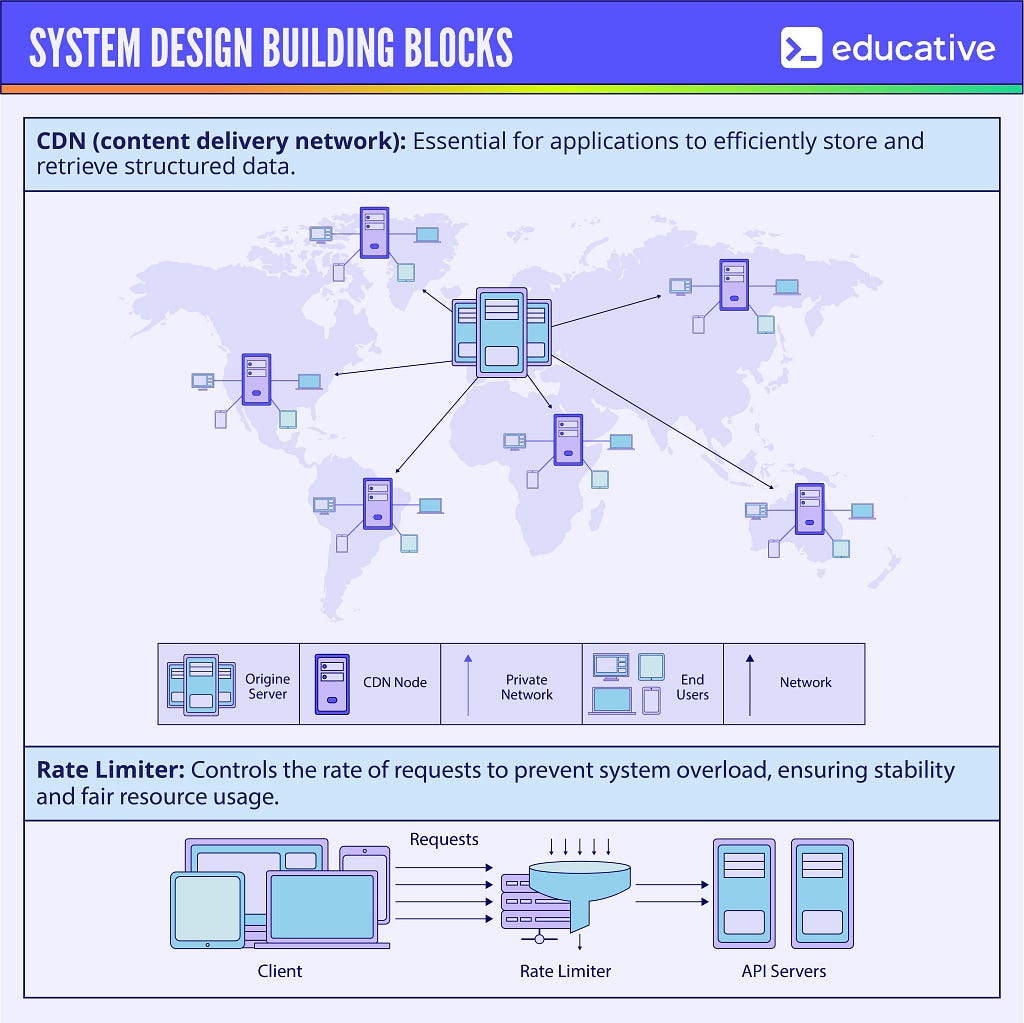
2 Databases
Databases are core components of nearly every system, enabling persistent storage and efficient retrieval of structured or unstructured data.
From relational databases like PostgreSQL and MySQL to NoSQL options like MongoDB and Cassandra, different databases are chosen based on scalability, consistency, latency, and data modeling needs.
They support features such as indexing, transactions, and replication, which are critical for performance, reliability, and fault tolerance.
Designing systems with the right database ensures optimal query performance, data integrity, and system scalability.

3. Rate Limiter
A Rate Limiter is a control mechanism used to regulate the number of requests a client can make to a service within a given time window.
It’s essential in protecting systems from abuse, ensuring fair usage, and managing traffic spikes. Techniques like token bucket, leaky bucket, and fixed window counters help enforce rate limits effectively.
Rate limiters are often deployed in API gateways, authentication services, and distributed systems to maintain system stability and avoid overloading backend resources.
Here is how Rate Limiter works:

4. Key Value Store
A Key-Value Store is a high-performance database that stores data as a collection of key-value pairs, allowing for constant-time complexity (O(1)) in most read/write operations.
It’s widely used in caching, session management, and real-time analytics due to its speed and simplicity. Systems like Redis, DynamoDB, and RocksDB are popular choices in modern architectures.
Because of their scalability and ease of distribution, key-value stores are a crucial component in building highly responsive, distributed systems.
Here is how a key-value store looks like:

5. Domain Name System (DNS)
The DNS is often referred to as the phonebook of the internet. It translates domain names like example.com into IP addresses. Without DNS, users would need to remember long strings of numbers to access websites.
Example: AWS Route 53, Google DNS

6. Load Balancing
Load balancers distribute incoming network traffic across multiple servers to ensure reliability and scalability. They prevent a single server from being overwhelmed.
Example: Nginx, HAProxy, AWS Elastic Load Balancing
Here is a nice diagram from Educative.io which shows a Load Balancer distributing incoming web traffic among multiple web servers to ensure no single server is overwhelmed.

7. Load Balancing Algorithms
Different algorithms determine how load balancers distribute traffic:
- Round Robin: Sequentially distributes traffic
- Least Connections: Routes traffic to the server with the fewest active connections
- IP Hash: Maps traffic to servers based on the client’s IP
Here is a nice list of all load balancing algorithms from DesignGurus.io

8. Caching
Caching temporarily stores copies of data to speed up access. It’s widely used to reduce latency and minimize database queries.
Example: Redis, Memcached
Here is also a quick guide of different types of caches in a system from DesignGurus.io, one of my favorite place when it comes to System design preparation.

9. Caching Strategies
Strategies for caching include:
- Write-Through: Updates the cache and the database simultaneously
- Write-Back: Writes data to the cache and updates the database asynchronously
- Read-Through: Reads from the cache, and if data is absent, it fetches from the database
And, here is a nice diagram from ByteByteGo which shows the top 5 caching strategies:
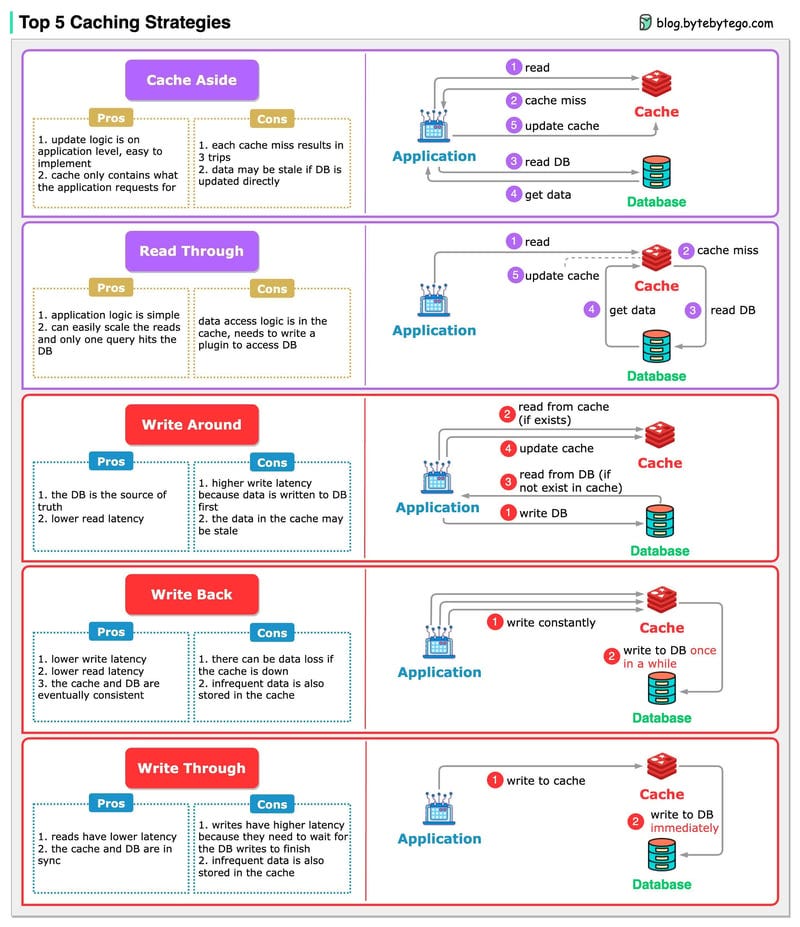
10. Cache Eviction Policies
When caches run out of space, eviction policies determine which data to remove:
- Least Recently Used (LRU)
- First In, First Out (FIFO)
- Least Frequently Used (LFU)
Here is another great diagram from ByteByteGo on 8 essential cache Eviction Strategies:
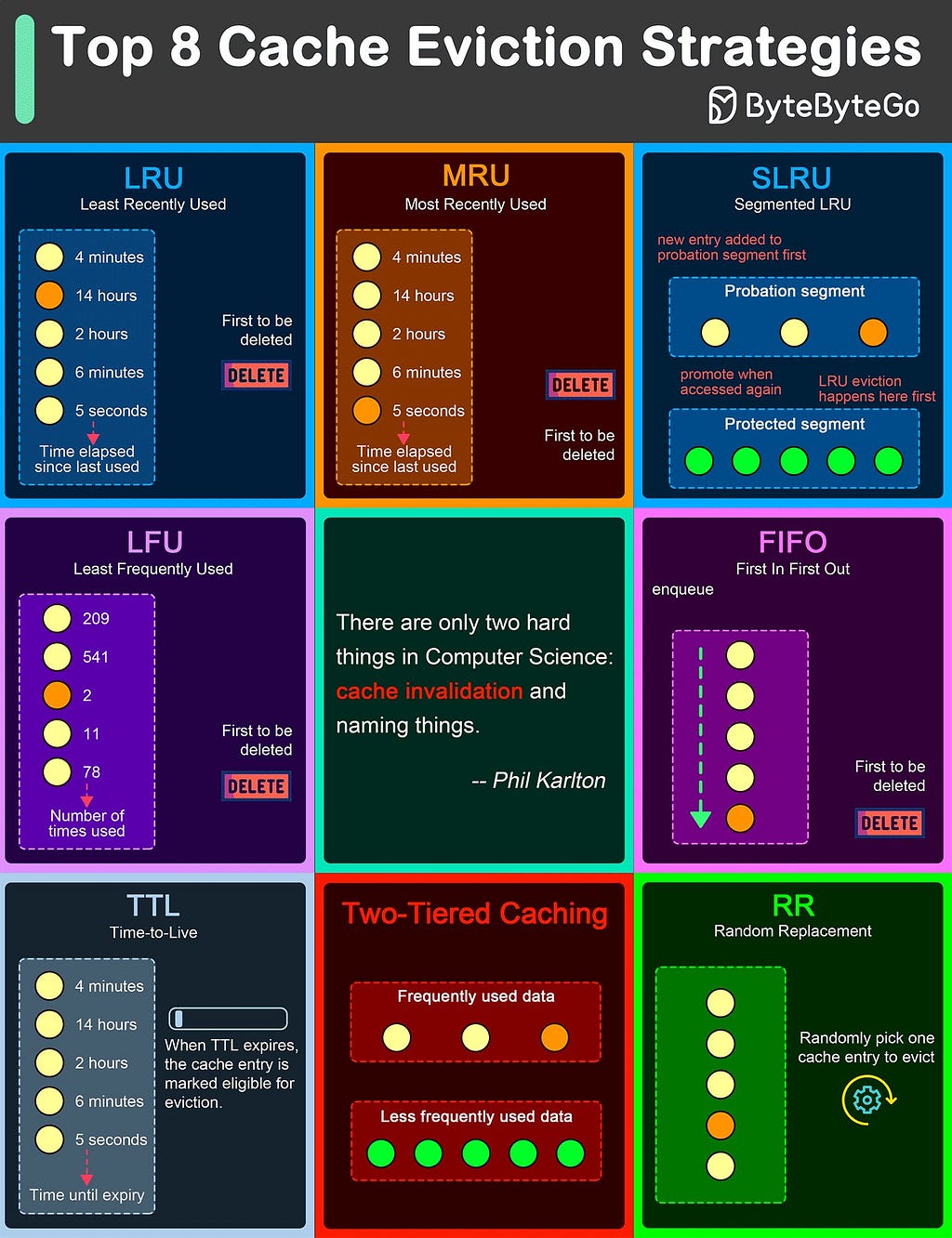
11. Distributed Caching
Distributed caching enables systems to share cached data across multiple servers, ensuring scalability and reducing bottlenecks in high-traffic applications.
Example: Amazon ElastiCache
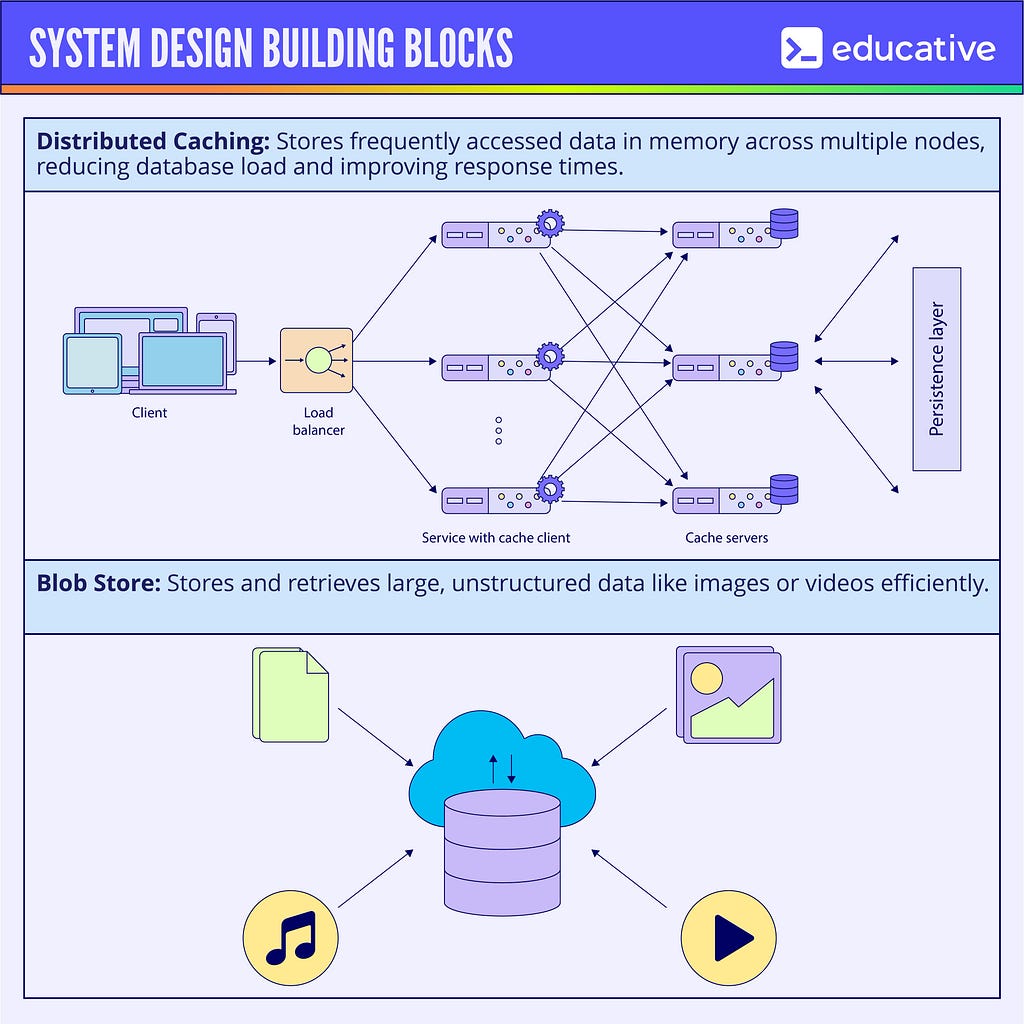
11. Heartbeats
Heartbeat signals are periodic messages sent between distributed systems to ensure components are alive and healthy. They’re crucial for failure detection and maintaining system integrity.
Here is a nice diagram which shows how Heartbeats works:

12. Message Queues
Message queues decouple services by enabling asynchronous communication. They ensure reliable delivery of messages between components.
Example: RabbitMQ, Kafka, Amazon SQS
You can learn more about message queues here.
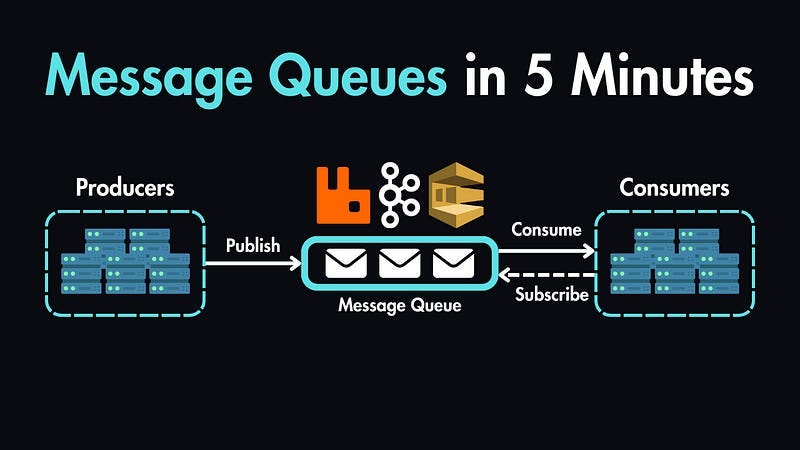
13. WebSockets
WebSockets provide full-duplex communication channels over a single TCP connection, enabling real-time updates like chat apps and live feeds.
Example: Socket.IO
Here is an example of how WebSockets can be used in System Design

14. Bloom Filters
A Bloom filter is a space-efficient probabilistic data structure used to test whether an element is part of a set. It’s fast but can return false positives.
Example: Preventing duplicate entries in databases
Here is how Bloom Filter works

15. API Gateway
An API Gateway acts as a single entry point for API calls, managing authentication, rate limiting, and data aggregation.
Example: AWS API Gateway
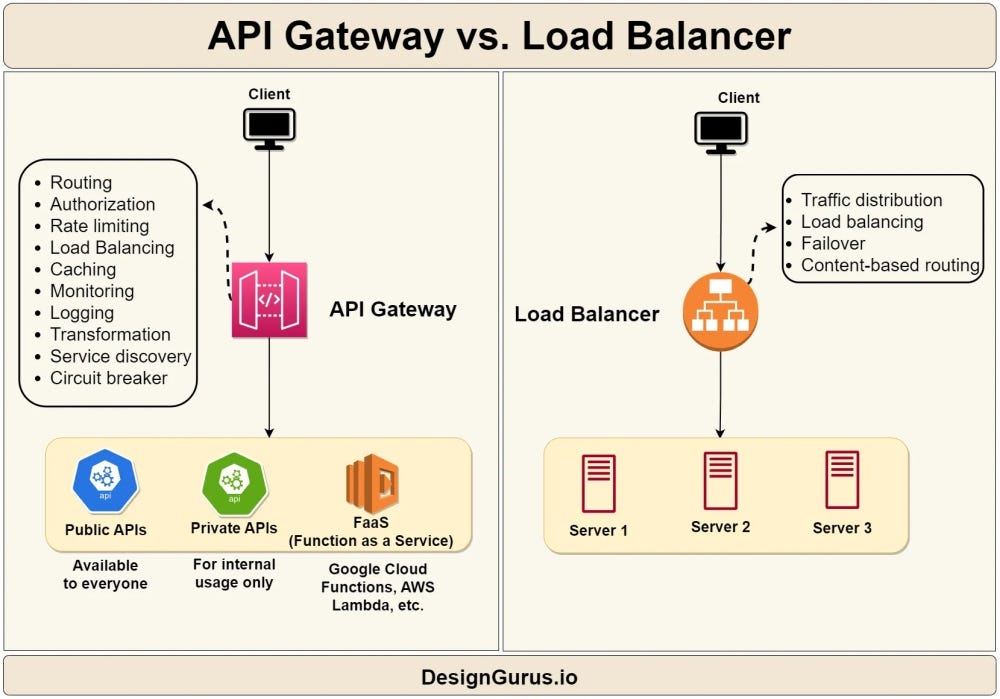
16. API Design
Good API design involves:
- RESTful APIs: Follow standard HTTP methods and conventions
- GraphQL: Enables clients to query only the data they need
- gRPC: Ensures high performance in communication between services
If you want to learn more about API Design, you can also checkout Grokking the API Design Interview course on Educative.io, its one of the best course on this topic.

17. Idempotency
Idempotency ensures that multiple identical requests have the same effect as a single request. This is critical in payment processing and state updates.
18. Checksum
A checksum is a value used to verify data integrity. By comparing checksums, systems can detect data corruption during storage or transmission.
Example: MD5, SHA-256
19. Distributed Locking
Distributed locks prevent race conditions in distributed systems. They ensure that only one process can access a critical resource at a time.
Example: Redlock algorithm using Redis
Here is an example of how Distributed Locking works in Kubernetes:

20. Monitoring and Observability
Monitoring tools and observability practices are essential for identifying issues and ensuring system health. They provide insights into metrics, logs, and traces.
Example: Prometheus, Grafana, Datadog
Here are all the tools you can use for monitoring your system.

21. Blob Store
A Blob Store (Binary Large Object Store) is a storage system optimized for handling large volumes of unstructured data such as images, videos, audio files, and backups.
Unlike traditional databases, blob stores are designed to store massive files efficiently and provide high availability and durability.
Common implementations like Amazon S3, Google Cloud Storage, and Azure Blob Storage allow developers to access and manage blobs using simple APIs.
Blob stores are essential for scalable applications that need to manage static assets or media content at a large scale.
22. Circuit Breaker
A circuit breaker prevents cascading failures by stopping requests to a failing service until it recovers. It protects the overall system from downtime.
Example: Netflix’s Hystrix
23. Proxy vs Reverse Proxy
- Proxy: Acts on behalf of the client to communicate with a server.
- Reverse Proxy: Acts on behalf of the server, handling requests from clients.
Example: Nginx, Apache HTTP Server

How these System Design Building Blocks Used in a Real-World Application: E-Commerce Platform?
Imagine designing an e-commerce platform like Amazon, how are you going to use these system design building blocks?
Well you can use:
- DNS and Load Balancers handle high traffic during sales events.
- Caching stores product details and inventory to reduce database load.
- Message Queues ensure asynchronous processing of order placements.
- Distributed Locks prevent duplicate inventory deductions.
- Circuit Breakers stop cascading failures when payment gateways are unavailable.
- API Gateway simplifies frontend-backend communication for mobile, web, and desktop apps.
Best Resources for System Design Interview Preparation
If you are learning System Design for interview then here are the resources I personally used during my preparation:
- Alex Xu’s “System Design Interview” Book (Both Volume 1 & 2)
- Interview Kick Start for Mock Interviews
- DesignGuru’s Grokking System Design Course
- Codemia.io : — Leetcode for System Design
- Concept and Coding YouTube Channel
- Hello Interview YouTube Channel and Website
- Awesome High-Level Design GitHub Repo
- Gaurav Sen’s System Design YouTube Channel
If you combine these resources with focused practice on the topics listed above, your chances of clearing the next SDE System Design round skyrocket.
And, here is a nice System Design cheat sheet from ByteByteGo to remember key System Design concepts easily
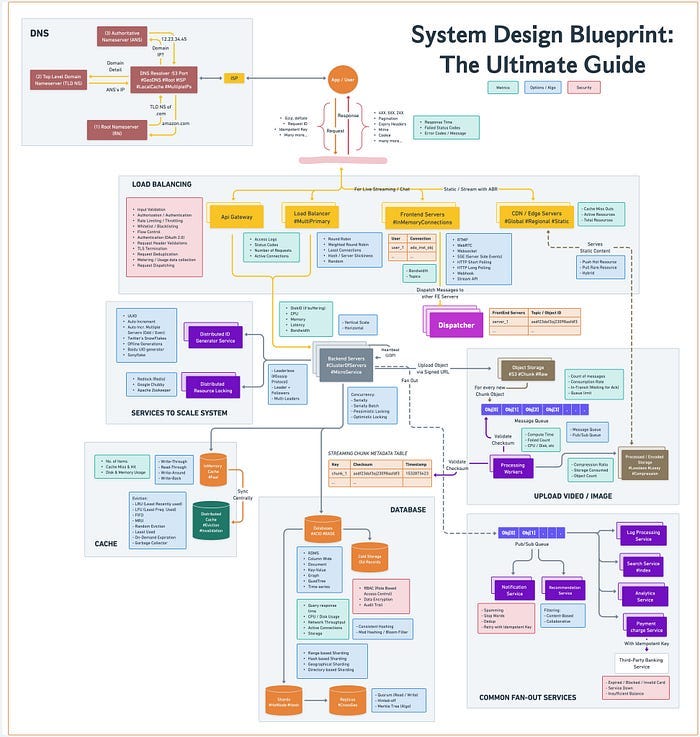
That’s all about the 21 System Design Building blocks every developer should learn. By using these 21 building blocks, you can design systems that scale effortlessly, handle failure gracefully, and provide a seamless user experience.
Which of these building blocks have you implemented in your projects? Let us know in the comments!
Other System Design Tutorials and Resources you may like
- Is DesignGuru’s System Design Course worth it
- Is Exponent’s System Design Course worth it?
- 10 Best Places to Learn System Design in 2025
- How to Prepare for System Design Interview in 2025
- Is ByteByteGo worth the hype?
- My Favorite Software Design Courses for 2025
- 3 Places to Practice System Design Mock interviews
- Is Designing Data-intensive application book worth reading?
All the best for your System Design Interviews, if you have any doubts or questions, feel free to ask in the comments.
P. S. — If you just want to do one thing at this moment, go join ByteByteGo and start learning System Design concepts, you will thank me later. Make it a goal for the new year and you will surely be a better Software Engineer.
21 Essential System Design Building Blocks for Software Engineers was originally published in Javarevisited on Medium, where people are continuing the conversation by highlighting and responding to this story.
This post first appeared on Read More

